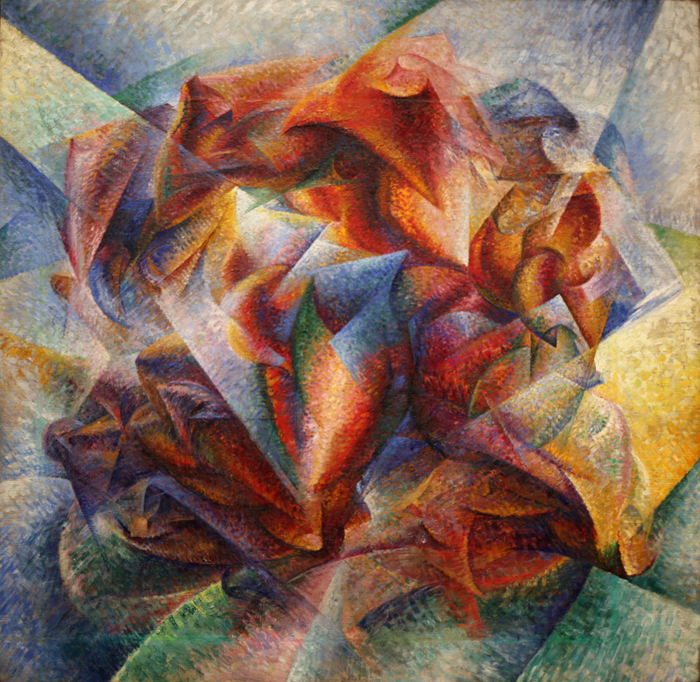Below are two photographs that have been made in response to the manifesto of Futurism – ‘Dynanism of a Car‘ by Luigi Russolo and ‘Dynanism of a Soccer Player’ by Umberto Boccioni.
‘Dynanism of a Car‘

The colours within this work are very intense – the yellow colours make the viewer think of the headlights of a car as well as the red. This use of hot colours throughout the work adds to the feeling that the car in the painting is going at a very fast speed – which could reflect how Futurists feel about how the world should be. The use of the hard hot colours creates a contrast with the black of the de-constructed car which creates a more sleek and eye-catching design. The use of the yellows and reds have connotations to fire and the way the colour fades out in places can be seen as patterns that would be seen in a physical flame. There is no 3D effect within this photograph but there is an intense feeling of direction within it. The shape of the aero-dynamic modelled car can be seen even though it has been deconstructed and re-arranged. Russolo added to the affect of the aero-dynamic shape by horizontally stacking red arrows pointing in the direction of the car’s motion in order to give a sense of direction and movement within the photograph. ‘Dynanism of a Car‘ takes a car and de-constructs it into new entities that are then re-arranged into a new interpretation of the same car – this shows Cubist influences which was another artistic movement that de-constructs the subjects.
This piece of art by Luigi Russolo, titled ‘Dynanism of a Car‘ is a great example of the type of work produced during the movement of futurism in Italy. Futurism is a rejection of the past and a celebration of speed, machinery, violence, youth and industry. Futurists insist that literature will not be overtaken by progress, rather, it will absorb progress in its evolution. This art was produced in 1912 and produces an image reminiscent of chronophotography by introducing the time dimension of speed in painting.
The painting was produced in 1912 but the image seems to display a modern bat-mobile type supercar which shows the forward-thinking attitude within Futurism. Russolo is trying to convey the idea of motion by creating the impression of soundwaves in the front of the car. Russolo would often focus on the technological innovation and the visual manifestation of motion which can clearly be seen within ‘Dynanism of a Car‘. The picture is also similar to physics textbook pictures illustrating the Doppler effect which supports the idea that Russolo was intending to show the compression of soundwaves through this photograph.

‘Dynanism of a Soccer Player‘

Boccioni uses highly contrasting colours in ‘Dynanism of a Soccer Player‘ along with extremely vibrant hues divided into sections that are reflective of rays of light – possibly coming from around the football stadium. Boccioni is focused on representing these vibrant colours and a sense of dynamics of movement within the painting rather than depicting the player. The dynamic movement feeling spread throughout the painting is done through abstract shapes of different opacity overlapping eachother – which has Cubist influences, similarly to ‘Dynanism of a Car‘. The work is intended to show a soccer players dynamic movement through an abstract series of shapes and kaleidoscopic colours. The soccer player is dematerialized into a luminous array of colours which could be seen as the colours and lights seen in a typical football stadium in which there are seas of fans in different coloured football kits supporting the soccer players. The only part of the soccer player that can be made out is the calf at the centre
‘Dynanism of a Soccer Player‘ was produced in 1913 by Futurist artist Umberto Boccioni who was a member of the Italian Futurists – a group of artists active around World War 1, which is a rejection of the past and a celebration of speed, machinery, violence, youth and industry. Futurists are firm believers of moving technology and life forward at a fast pace, which can often be seen through their art. . This piece demonstrates a quote from Boccioni from 1910, he said “To paint a human figure you must not paint it; you must render the whole of its surrounding atmosphere…movement and light destroy the materiality of bodies”.
Through abstraction and sense of dynamic movement Umberto Boccioni has challenged the conventional stillness of paint on canvas in order to create something exciting and different to the viewer. The viewer is forced by Boccioni to rethink aesthetic sensations and their original perception of surrounding objects due to the chaos of abstract shapes within the painting.
